6 Things You Should Never Do When Training Biceps
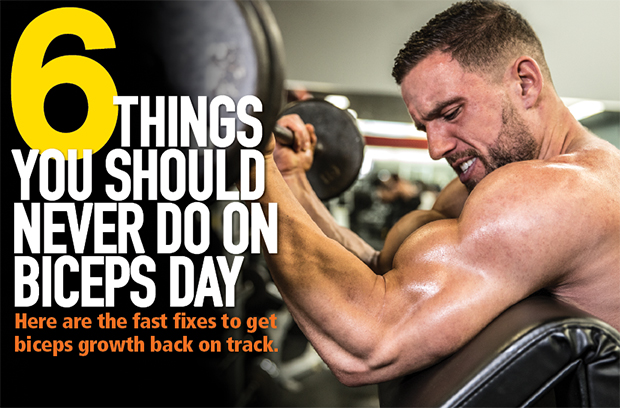
Even a motion as simple as a curl can be fouled up. Here are the biggest arm-day offenders and fast fixes to get biceps growth back on track.
Want big guns? The recipe is simple: Just curl, baby. Pretty basic, really, yet all too many trainers still find ways to mess it up. How so? Can you believe we found six all-too-common blunders! What made the list? Let’s get to it so you can get back on track in your pursuit of sleeve-busting arms.
1. Never begin your workout with the wrong exercise.
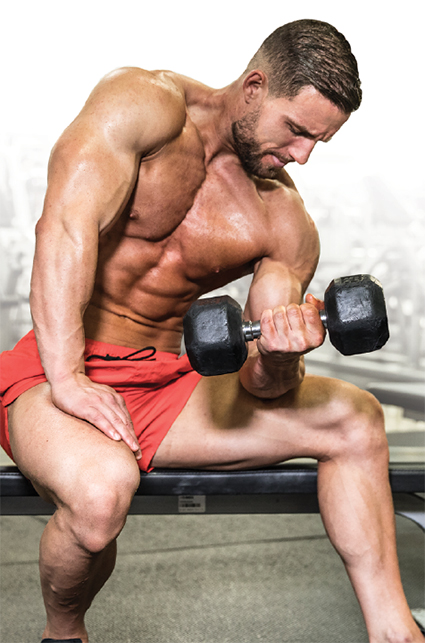 Warm-ups and pre-exhaust aside, would you ever start a thigh workout with leg extensions or a chest workout with dumbbell flyes? No way! So why, then, would you want to begin your arm session with an isolation exercise that limits the amount of weight you can use?
Warm-ups and pre-exhaust aside, would you ever start a thigh workout with leg extensions or a chest workout with dumbbell flyes? No way! So why, then, would you want to begin your arm session with an isolation exercise that limits the amount of weight you can use?
For sure, multi-joint exercises should always be your first consideration when training a muscle group because of their ability to recruit more muscle mass, allow you to handle heavier loads, and generate a greater anabolic stimulus—all proven! From that perspective, a weightedchin-up (that’s the one with an underhandgrip) is a clear winner, and there’s even some evidence to suggest so.1
But the rest of the bunch include just single-joint exercises, so how do you differentiate from there? Go by load. Seated and very restrictive isolation exercises limit the amount of weight you can use, whereas standing bilateral movements in which you can generate a bit of momentum do just the opposite.
You can even test this on yourself. What’s your working weight for 8 reps with concentration curls? Compare that to half the load you use with standing curls. There’s your answer. In that regard, besides weighted chin-ups, standing barbell or EZ-bar curls are likely your best bet. With a shoulder-width grip, they hit both the long and short heads about evenly.
Choosing the right movement doesn’t mean you’re completely out of the woods because you still have to load it right. After warm-ups, to maximize hypertrophy, choose a weight that causes muscle failure at 8 to 12 reps. For me, I like to target the lower end of the rep range at the beginning of my workout when I’m strongest, sometimes going as low as just 6 to 8 reps.
2. Never repeat similar arm movements.
 There’s a reason you don’t do a chest workout that consists of flat-bench barbell presses, flat-bench dumbbell presses, and machine bench presses that mimic the flat bench angle. Namely, they pretty much work the chest musculature in very similar ways, which can limit the degree of overall stimulation in a given workout and over time, fail to optimize growth. That’s why, in fact, chest workouts typically consist of hitting the pecs from multiple angles, including incline and decline.
There’s a reason you don’t do a chest workout that consists of flat-bench barbell presses, flat-bench dumbbell presses, and machine bench presses that mimic the flat bench angle. Namely, they pretty much work the chest musculature in very similar ways, which can limit the degree of overall stimulation in a given workout and over time, fail to optimize growth. That’s why, in fact, chest workouts typically consist of hitting the pecs from multiple angles, including incline and decline.
Just because the body part changes doesn’t mean the approach does. When it comes to the arm flexors, a multi-angle approach to exercise choice is still the way to go.
But that’s not what happens if you pair standing curls with a supinated (underhand) grip with a barbell, dumbbells, a machine, and even (possibly) cables. They’re just too much alike, with your elbows positioned beside your body. Instead, vary the angles by manipulating elbow position, best seen when doing preacher curls (elbows in front of your torso) and incline-bench dumbbell curls (elbows behind the plane of your torso so long as you don’t pull them forward as you curl). Those variations better target the short and long heads, respectively. Throw in some cable movements from various pulley positions and you’ll have a multitude of lines of stimulus on both biceps heads.
3. Never fear using alternative grips.
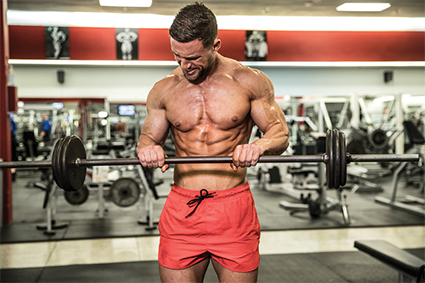 Grip width and hand position (up, down, neutral) can also affect muscle recruitment, just like elbow position relative to your torso. Let’s start with the biceps’ long head, the one that makes up the peak of your biceps and is sometimes called the outer head. According to exercise scientist and author Jim Stoppani, PhD, using a grip inside shoulder width when doing barbell curls emphasizes its development, though one should never confuse that with isolation. Conversely, Stoppani says using a grip that’s outside shoulder width will instead shift the focus primarily to the short (or inner) head.
Grip width and hand position (up, down, neutral) can also affect muscle recruitment, just like elbow position relative to your torso. Let’s start with the biceps’ long head, the one that makes up the peak of your biceps and is sometimes called the outer head. According to exercise scientist and author Jim Stoppani, PhD, using a grip inside shoulder width when doing barbell curls emphasizes its development, though one should never confuse that with isolation. Conversely, Stoppani says using a grip that’s outside shoulder width will instead shift the focus primarily to the short (or inner) head.
With that in mind, you can work both heads to greater or lesser degrees from one set to the next or one workout to the next.
But there’s more. Switching from an underhand (supinated) grip to a neutral (hammer grip) better hits the brachialis, an arm flexor that lies underneath the biceps. Boosting its size will also help increase overall arm girth. Hammer curls with dumbbells or a rope attached to a lower cable work well here.
And finally, when you take an overhand grip, you better target the brachioradialis, which provides thickness to the thumb side of upper forearm. We call this movement a reverse curl. Ultimately, using all these types of grips will better maximize arm development.
4. Never curl as high as possible.
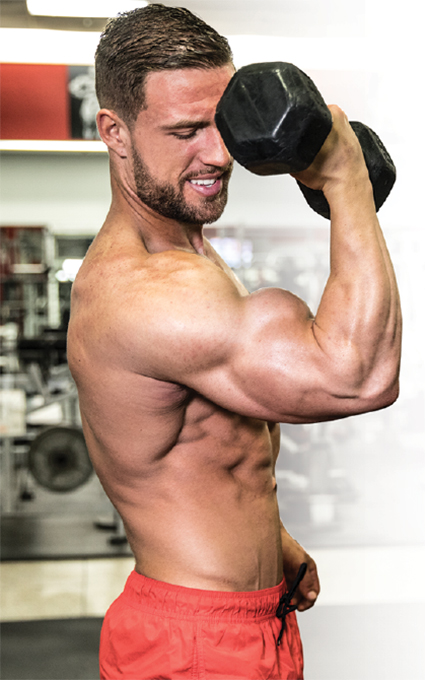 Everyone knows they should use the full range of motion when training. Sometimes, when those final inches are really tough, we stop short of a full ROM, but what about when those final inches are really easy? This mistake falls into the latter situation.
Everyone knows they should use the full range of motion when training. Sometimes, when those final inches are really tough, we stop short of a full ROM, but what about when those final inches are really easy? This mistake falls into the latter situation.
Taking your biceps curl as high as possible—regardless of the particular exercise you’re doing—means curling to about shoulder level, or a bit higher. But to actually do so means pulling your elbows forward from their position that’s supposed to be locked by your sides. That’s where another muscle starts to kick in, the front delts—and remember, this is supposed to be a single-joint movement that involves only the elbow joint.
Any effort to raise the weight as high as possible requires help from the front delts, and at that point, your hands are basically stacked above your elbows (go ahead and take a look from the side), which, for the biceps, means that for all intents and purposes you’ve now discovered a resting spot, reducing tension on the muscle. Sure, the front delts are now highly engaged, but I suspect few of you had that in mind. Just because you can go higher doesn’t mean you should. In fact when curling, go only as high as possible so long as your elbows remain locked by your sides. You may certainly use cheat form on selective reps, but that should be the exception to the rule.
5. Never train biceps before back.
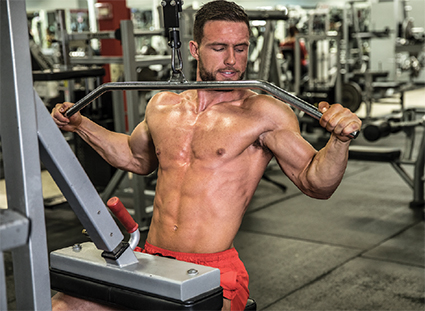 What’s the best way to ruin a back workout? Train your biceps first! Regardless of your training split, you work larger muscle groups before smaller ones, which is why chest is trained before shoulders or triceps if they’re trained together, and back before biceps. The arm flexors are fairly small but are important in rowing and other pulling motions for the back, so you want them fresh and not prefatigued when tackling heavy weights on back day.
What’s the best way to ruin a back workout? Train your biceps first! Regardless of your training split, you work larger muscle groups before smaller ones, which is why chest is trained before shoulders or triceps if they’re trained together, and back before biceps. The arm flexors are fairly small but are important in rowing and other pulling motions for the back, so you want them fresh and not prefatigued when tackling heavy weights on back day.
I’ve seen plenty of folks who prioritize their arms before back instead, with predictable results. If your biceps are heavily fatigued before a back exercise, which muscle group do you think is going to give out first on a heavy set? No doubt, your performance is going to really suffer if you did biceps first on this training day. Switch ‘em or separate your training days.
6. Never rely exclusively on cheat curls.
 Previously, we mentioned how lifters found a way to cheat by recruiting the front delts into the movement, but that’s certainly not the only way trainers take muscular stress off the target muscle. The most common is simply a phenomenon called cheat curls, which entail everything from a little body English and momentum to throwing your entire back and legs into the motion to help you overcome a sticking point during the movement. The question then becomes, how much cheating is acceptable?
Previously, we mentioned how lifters found a way to cheat by recruiting the front delts into the movement, but that’s certainly not the only way trainers take muscular stress off the target muscle. The most common is simply a phenomenon called cheat curls, which entail everything from a little body English and momentum to throwing your entire back and legs into the motion to help you overcome a sticking point during the movement. The question then becomes, how much cheating is acceptable?
Let’s start with where the extra momentum is generated from. If you’re standing, it’s easily created through your hips to provide a little thrust, which must be increased on each successive rep as your biceps become increasingly fatigued. Because your spine (and spinal health) is involved, the trade-off must be considered. Remember, too, that using other muscle groups also means you’re reducing the workload done by the biceps, so diminishing returns is relevant because the more cheat curls you do, the less effective they become (at least on the biceps).
That being said, if you use a weight you can’tlift with good form for a single rep, meaning you’re cheating from the very start, it’s simply too heavy. You can’t handle the load, so you’re creating ways to effectively make it lighter via cheating from the get-go. If you can’t handle the load for a single rep, lighten the weight!
What’s better is being able to complete 6 or 7 reps on your own and then do just a few cheat reps to help keep the set going, keeping the degree of body swing to a minimum. Just enough body English to get over the sticking point, and you’ll find you can do another couple of reps you might not have been able to do otherwise. Sure, it’s a subjective measurement, but no one ever built big arms doing kettlebell swings!
Reference 1. Youdas JW, Amundson CL, Cicero KS, et al. Surface electromyographic activation patterns and elbow joint motion during a pull-up, chin-up, or perfect-pullup™ rotational exercise. J Strength Cond Res. 2010 Dec;24(12):3404-14. Get articles like this one delivered to your email each month by signing up for Muscle Insider’s mailing list. Just click here.

